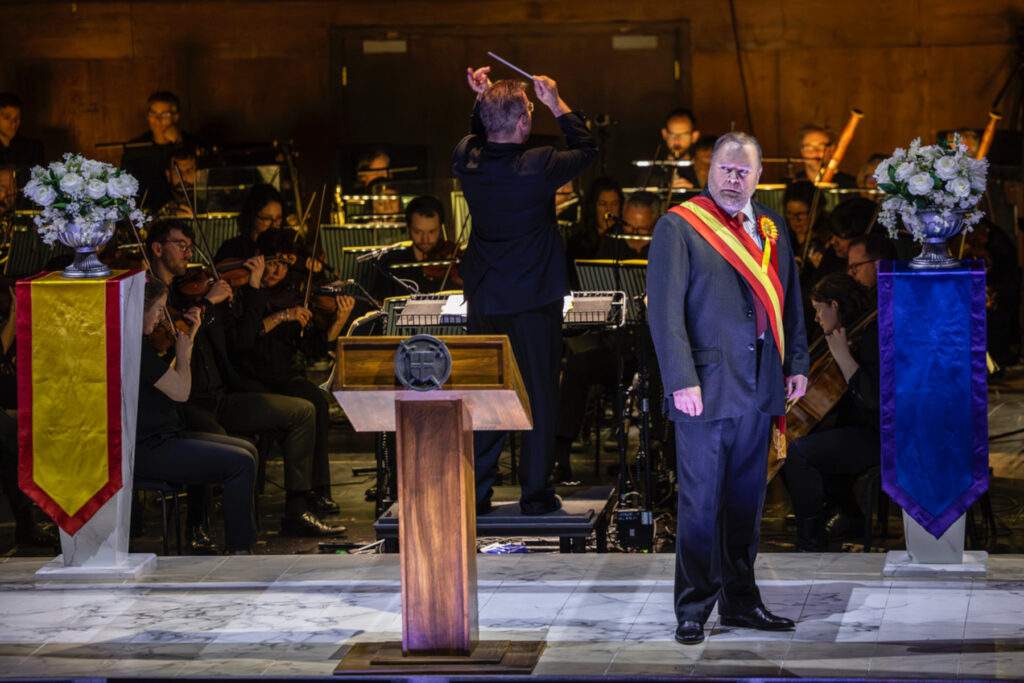What links Verdi with Shakespeare is a keen awareness of the distinction that needs to be made between the public and the private man: an individual may project a particular persona very different from the one that is hidden away from general view. Moreover, an exalted position within the power structures of a state does not lessen troubling conflicts when they occur; it heightens them. Verdi, whose younger sister died in adolescence and who by the age of 27 had already lost his wife and two infant children, knew all about suffering and trauma within the family. The two archetypal themes which he repeatedly explored in his operas centre around a loving but tortured father-daughter relationship and the need for a statesmanlike commitment to peace, brotherhood and reconciliation. These lie at the heart of his twentieth opera, Simon Boccanegra, premiered in Venice in 1857.
This opera did not get off to the best of starts. It was criticised for its labyrinthine plot and for the composer’s failure to continue the bel canto tradition of Donizetti and Bellini. By 1881, having cooperated with a new librettist, Arrigo Boito, and after incorporating the Council Chamber scene with its grand ensemble which closes Act 1, Verdi produced a revised version which is the one most regularly performed today, including this concert staging by Opera North. Some inadequacies remained, not least the fact that, as the musicologist Julian Budden observed, “all the characters define themselves against an ingeniously shifting pattern of intrigue”. This may help to explain why it is not one of Verdi’s most popular works, though it is ultimately the sublime music that sustains interest.

The title role is based on an historical figure. Simon Boccanegra, a former pirate and man of the people, was elected Doge (effectively head of state) of the city state of Genua in 1339. In the following decades until his death in 1363, he drove forward the intense commercial rivalry with Venice. He had fallen in love with Maria, the daughter of his political rival, the aristocratic Jacopo Fiesco, who bore him a daughter. The mother died soon thereafter; the child mysteriously disappeared, only to re-emerge years later as Amelia Grimaldi, now Fiesco’s adopted daughter. For his part Fiesco is in the guise of one Andrea Grimaldi, in hiding and plotting against Boccanegra, whose position he still craves. Meanwhile Amelia is determined to marry another of the Doge’s enemies, the Genoese nobleman Gabriele Adorno. Such convolutions in the storyline require constant audience alertness: those in the back row may not always be able to follow.
Opera North’s staging was minimal. An extended metal structure, indicating enclosed spaces, with an inner sanctuary at one end screened by voile curtaining; a few marble-like pillars, arches and benches suggestive of the corridors and councils of power; two proud banners proclaiming the rival factions of plebeians and patricians, suspended from the ceiling. I had a few niggles about the costumes, which brought the action clearly up to the present-day. Gabriele, ostensibly a nobleman, was disconcertingly attired in denim jeans and a casual jacket. Occasional naval uniforms more reminiscent of RNLI officials, and the wedding couple kitted out in formal but charcoal-grey clothing were hardly coherent.

In itself, all that would have been sufficient. Instead, all the leading characters were required to sport party-political rosettes reminiscent of electoral battles in UK constituencies, with the colours of red-and-yellow for the “Plebe” and purple-and-blue for the “Patrizi”. This lent the wrong kind of association to factional strife within the Genoese community: not at all about respectful hustings but engaged in violent threats and the deliberate cancelling of opponents including murder. This should have been more about warring Montagues and Capulets, or Jets and Sharks, than about opposing political groupings.
One of the undoubted glories of Opera North’s operatic stagings, now and in the past, is the way in which the orchestra is placed centre-stage. This allows the most incredible detail to emerge, even at quite reduced dynamic levels, with a visceral quality to ensemble pieces. Orchestral execution was not entirely faultless, but the commitment of all the players did not for one moment waver, inspired by the emotionally charged and dramatically accentuated conducting of Antony Hermus. Again and again I marvelled at the beauties in Verdi’s score: the long and sweeping cantilenas, exquisitely sustained by the rich, warm body of strings, as impressive in moments of susurration as in powerful chording; their gentle undulations mimicking the action of the waves; their slithering up and down scales together with the ominous low brass designed to unsettle as the slow poisoning of Boccanegra takes effect. Wind and brass too benefited from the master-magician Verdi’s ear for expert colouring: a bass clarinet solo as Boccanegra reveals he knows the identity of the chief plotter against him, or the trombones, as black and baleful here as in all the composer’s other scores. From the brief prelude at the start, completely unlike what might be expected, sounding more like a Brahms lullaby or a pastoral passage from early Vaughan Williams, down to the tolling of a bell at the death of Boccanegra, this is one of Verdi’s finest operatic achievements. The Chorus of Opera North was deployed very effectively throughout: double choruses in the choir stalls, off-stage voices, and the flanking of both outer aisles in the Royal Festival Hall. Their singing was an absolute credit to their Chorus Master, Anthony Kraus.

Which prompts the obvious question: why is it that despite the potency of passion, power and poison, and such a magisterial score, Simon Boccanegra is not better known and more often performed? I have come to the conclusion that this is due to the predominance of male voices. There is only one soprano role (Boccanegra’s daughter) and only one tenor role (Gabriele, sworn to avenge his father’s killing by Boccanegra); the heavy weighting towards baritones and basses, often maximising their lower registers, gives this work its special tinta.
But what refulgence we had in Opera North’s casting! As Boccanegra’s daughter Amelia there was Sara Cortolezzis, fresh-toned from the start with a peachy top line and a security that extended into her chest register, immediately affecting in her first main aria, “Come in quest’ora bruna”, in which she sings of the sea and stars shining brightly in the morning light as she waits for her lover Gabriele. She too is tossed onto the waves of inner conflict, initially reluctant to confide in him when she learns who her biological father is, but she stops him from drawing the knife on Boccanegra after he has fallen asleep. Soon after, in a trio which she sings with Gabriele and Boccanegra himself, “Perdon, Amelia…Indomito”, her role in overcoming and reconciling opposing forces becomes pivotal. Cortolezzis was excellent in exposing the conflict in her soul, desperate to retain the love of both her father and her chosen partner, and her total anguish in the closing scene when she knows Boccanegra is about to take his final breath.

Fiesco, the role of her supposed guardian (her actual grandfather), was sung by the Armenian-German bass, Vazgen Gazaryan, already impressive in his Prologue lament, “Il lacerate spirito”, at the passing of his own daughter Maria. His voice, inky-black in colouring and cavernous in its deepest reaches; his demeanour defiant and steadfast in opposition to Boccanegra until their wonderfully moving duet in Act 3 where the family reconciliation is effected.
In its choice of the Uruguayan tenor, Andrés Presno, as Gabriele, Opera North again demonstrated its expertise in casting. There was no mistaking the lyrical ardour in his voice, especially in his battle with Paolo, his rival for the heart of Amelia, but its lustrous power and suppleness in phrasing were most particularly evident in his Act 2 aria, “Sento avvampar nell’anima”, where his furious jealousy emerges in a mistaken assumption that Amelia is Boccanegra’s mistress.
In turn, Mandla Mndebele had all the necessary baritonal stature and authority in his role as Paolo, initially one of Boccanegra’s trusted councillors but later a conspirator against him. All the other minor parts were well taken.
Which leaves the principal character, the one-time corsair and then Doge, Simon Boccanegra himself. There was plenty of heft in Roland Wood’s voice, reflecting his buccaneering qualities, but also sensitivity to the shifting emotional needs. Pain and torment were on display in the Prologue, when he learns that Maria, the woman whom he loved and who bore him a daughter, has died; poignancy when he and Amelia share their pictorial mementos of Maria; fearlessness in the sight of the rioting mobs outside; tenderness after the poison begins to take hold and he expresses his nostalgic yearning to breathe again the blissful air of an open sky. Above all, Wood conveyed the statesmanship that Verdi imbued the role with, in his determination to bring about reconciliation between strife-torn families and communities. At the end of Act 2, echoing the voice of the composer himself, he declares: Let my memorial be a united Italy.
Petrarch’s line, “I’vo gridando: Pace, pace, pace” was emblazoned over the top of the Opera North staging. In his cry for peace the poet attested to the human need to lay aside hatred, resentment and desires for vengeance, a cry that has resonated throughout the ages and still resonates today. It was perhaps the most powerful of all statements in this magnificent Opera North production.
Alexander Hall
Simon Boccanegra
Opera in a Prologue and three Acts by Giuseppe Verdi to a libretto by Francesco Maria Piave and Arrigo Boito, based on a play of the same name by Antonio Garcia Gutiérrez
Concert staging by Opera North of the 1881 revised version
Sung in Italian with titles in English
Cast and Production Staff:
Simon Boccanegra – Roland Wood; Fiesco – Vazgen Gazaryan; Amelia – Sara Cortolezzis; Adorno – Andrés Presno; Paolo Albiani – Mandla Mndebele; Pietro – Richard Mosley-Evans; Amelia’s maid – Laura Kelly-McInroy; A Captain – Ivan Sharpe
Director – P J Harris; Designer – Anna Reid; Lighting Designer – Richard Moore; Chorus of Opera North, Chorus Master Anthony Kraus; Orchestra of Opera North, Conductor Antony Hermus
Royal Festival Hall, Southbank Centre London, 24 May 2025
Top image: The death of Simon Boccanegra (Roland Wood)
All photos © James Glossop